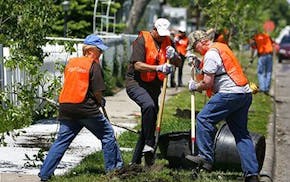ANCHORAGE, Alaska - Count me as a believer.
We were driving down the narrow highway tucked between the steep cliffs of the Chugach Mountains on one side and the cold waters of the Turnagain Arm off Cook Inlet on the other when my host broke into her sermon.
"Do you know how important salmon is to Alaskans? It's about life," said my cousin, who landed in Alaska five years ago with her family and has taken up salmon fishing the way others in the Lower 48 do golf or gardening. "It is life."
Second-graders dissect salmon, kids nibble on smoked salmon for snacks, the local pub is called Humpy's (that would be a type of salmon), the image of the fierce fish is everywhere, from native art to jewelry to sculptural signs and murals. And, of course, the fish is on menus -- for both people and bears.
"I love salmon," she said with a sweep of her arm toward the water.
What the potato was to Ireland, what corn, beans and chiles are to the Southwest, salmon is to Alaska: sustenance. For 10,000 years, the Yupik Natives in the Yukon have depended on this fish for subsistence, they who live so far afield that they can be reached only by boat or plane. And they aren't alone in their need -- and preference -- for salmon.
Throughout the state, Alaskans of all backgrounds stand shoulder to shoulder in rivers during July when dip-netting is allowed, capturing their year's supply of sockeye and pinks, to be canned, smoked or frozen -- and, perhaps, bartered. From Homer to Valdez, and points between and beyond, fishing boats and camp coolers are filled with the fish.
Government programs re-commend salmon for meals twice a week. State officials regulate the fish carefully and monitor its numbers (state law forbids farm-raising of the fish), which shouldn't be surprising in a region where there is a marine highway and the Yukon is the world's longest salmon river.
Consider this: Salmon outnumbers people in the state 1,500 to one. Alaska provides 90 percent of North America's wild salmon harvest. More than 50 million salmon pass through Bristol Bay in a little over three weeks.
No wonder the state fish is the king salmon.
A fish tale of strength
Salmon even comes with a story. It starts life in a freshwater river, follows the water to the sea, travels thousands of miles in the coldest of water -- usually the Bering Sea for the Pacific species -- then returns to the freshwater river where it was born, battling currents to spawn, some filling the bellies of brown bears along the way. Their orange-red flesh -- we call the color "salmon" for a reason -- comes from the krill they eat in the ocean.
Their oil and fat content depend on the length of the river in which they travel upstream -- the farther they have to go, the more fat they have, because the fish don't eat once they return to freshwater.
It's the fat that makes them so valuable, as it contains the omega-3s that are healthful. Those fats, acting more or less as antifreeze, keep the fish's muscle and tissue flexible in that very cold water.
Until the early 1970s, most salmon we ate in the Lower 48 was canned. That's when Norwegians started experimenting with farm-raising fish, and cooks worldwide had access to the fresh variety. Restaurants in New York now get their wild salmon from the Yupiks in Emmonak, Alaska, where a fishery was established in 2002.
Today, you're more likely to find farmed salmon than wild varieties in the grocery stores. Three times as much is farmed, much of it from Europe and Chile, where the fish are raised in cold, clean fjords.
A wild meal to remember
As I traveled the roads along the Kenai Peninsula and Prince William Sound, I found salmon on every menu, in salmon chowder, if nothing else, and in other dishes far beyond the slab of fillet or salmon steak that most of us are accustomed to seeing.
I can chart my travels by those cups of chowder I devoured, the best of which also included sweet corn. Thick or thin, with or without clams, always with potatoes, some with fresh corn or bacon, the bowls were never the same.
In the Twin Cities, I can find farm-raised salmon year-round, but it's the wild that has captured my fancy, never mind that it's available fresh only in the summer months and spilling into fall.
The wild salmon I tasted was from a fierce fish that needs free-flowing rivers, not ones constrained by dams or loss of trees or civilization.
Yes, I'm a believer.
And the next time I'm in Alaska, I'll be wearing waders.
Lee Svitak Dean • 612-673-1749

Yuen: Why do people forgive? It's messy, complex and 'the best form of self-interest'

Hark, downtown Minneapolis' only vegan, gluten-free cafe, closing April 28

Critics' picks: The 12 best things to do and see in the Twin Cities this week
How the Goo Goo Dolls learned the music biz from Minneapolis bands
